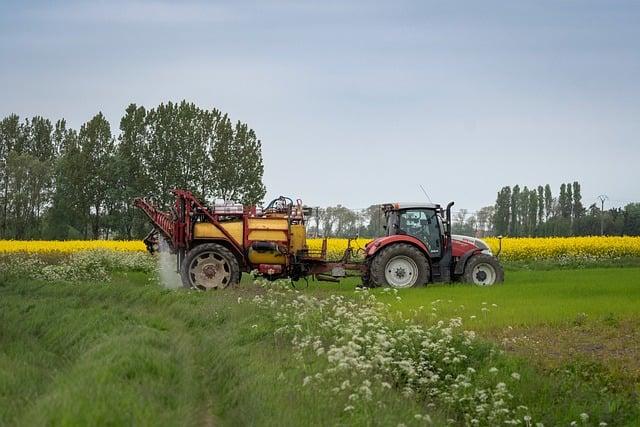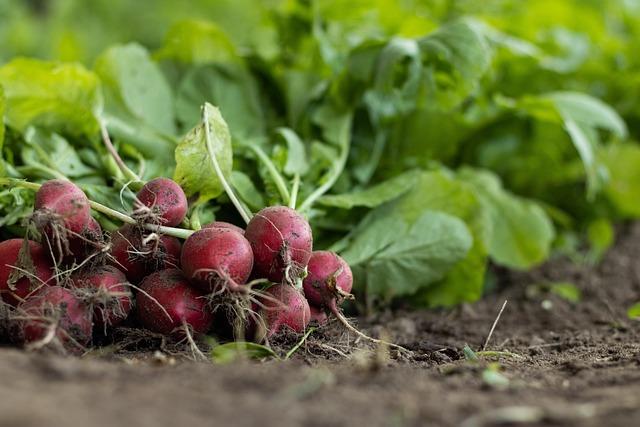The Zimbabwe Breadbasket Delusion: A Zombie Thought That Received’t Die
Within the center of Southern Africa, Zimbabwe has lengthy been heralded because the area’s breadbasket, a name that conjures photographs of fertile fields and bountiful harvests. Tho, this narrative has continued lengthy after the realities of agriculture within the nation have shifted dramatically. What used to be as soon as a thriving agricultural hub has confronted years of monetary decline, land reform controversies, and local weather demanding situations, main many to query the validity of this delusion. On this article,we delve into the origins of the Zimbabwe breadbasket legend,its evolution over the a long time,and why it continues to resurface in discussions about meals safety and agricultural coverage in Southern Africa.As we discover the complicated interaction of historical past, politics, and modern day realities, we goal to unpack how this ‘zombie concept’ clings to existence, defying the empirical proof that means a necessity for a extra nuanced figuring out of Zimbabwe’s agricultural panorama.
The Ancient Context of Zimbabwe’s Agricultural Prominence
The narrative of Zimbabwe because the “breadbasket of Africa” is steeped in historic complexity, rooted within the nation’s fertile lands and its agricultural attainable. This symbol can also be traced again to the early years of independence within the Nineteen Eighties, when the country boasted a thriving sector characterised by means of large-scale manufacturing of staple vegetation like maize and tobacco.Zimbabwe’s wealthy soils, blended with favorable climatic prerequisites, situated it as a significant exporter inside the area. Alternatively, this prominence started to get to the bottom of within the past due Nineteen Nineties and early 2000s, when land reform insurance policies ended in in style upheaval and the disruption of business farming, transferring the rural panorama vastly.
A number of elements contributed to the conversion of Zimbabwe’s agricultural superiority right into a narrative incessantly sufficient described as a delusion:
- Financial Mismanagement: Inflation and deficient governance weakened agricultural output.
- Land Reforms: The violent appropriation of white-owned farms seriously impacted productiveness.
- Local weather Exchange: Variability in climate patterns led to droughts and reduced crop yields.
- Marketplace Get right of entry to: Deteriorating business relationships reduced export alternatives.
| 12 months | exported Merchandise (in heaps) | Key Problems Confronted |
|---|---|---|
| 1990 | a million | Solid Manufacturing |
| 2000 | 500,000 | Land Reforms Initiated |
| 2010 | 200,000 | Critical Droughts |
| 2020 | 100,000 | Financial Instability |

Debunking the Breadbasket Delusion: Details As opposed to Fiction
For many years,Zimbabwe has been heralded because the “breadbasket of Africa,” a label that has been challenged by means of the realities at the floor. this perception incessantly sufficient romanticizes the rustic’s agricultural features, ignoring the systemic problems and financial turmoil that experience plagued the sphere. The exaggeration of Zimbabwe’s agricultural attainable shines thru when inspecting key statistics, together with a pointy decline in maize manufacturing and emerging meals lack of confidence ranges. key elements contributing to the disillusionment come with:
- Land Reform Insurance policies: The arguable land redistribution projects seriously disrupted business farming.
- Local weather Variability: Climate fluctuations, together with droughts and floods, have threatened crop yields.
- Financial Demanding situations: Hyperinflation and insufficient infrastructure have hampered agricultural investments.
Regardless of the patience of the breadbasket narrative, knowledge unearths a stark distinction between delusion and truth. A complete exam of agricultural outputs showcases the decline in key staples through the years, elevating questions concerning the sustainability of this belief. Under is a temporary comparability of agricultural output from 2000 to 2020:
| 12 months | Maize Manufacturing (MT) | Wheat Manufacturing (MT) |
|---|---|---|
| 2000 | 1,200,000 | 200,000 |
| 2010 | 800,000 | 150,000 |
| 2020 | 600,000 | 100,000 |
Sifting throughout the knowledge illustrates a being worried pattern that contradicts the glorified breadbasket narrative.The decline in each maize and wheat manufacturing underscores the pressing want for real looking exams and cutting edge methods to restore Zimbabwe’s agricultural sector,transferring previous nostalgic beliefs towards a extra sustainable long term.

Penalties of Perpetuating Inefficient Agricultural Narratives
The continuing repetition of out of date agricultural narratives now not best stifles innovation but additionally hampers the sphere’s skill to answer recent demanding situations. Through clinging to the perception of Zimbabwe because the “breadbasket of Africa,” stakeholders possibility neglecting extra related agricultural insurance policies that might deal with present problems reminiscent of local weather exchange, meals safety, and financial instability. This misaligned focal point perpetuates useful resource allocation towards normal vegetation and out of date farming ways, which in flip undermines the opportunity of diversification and modernization that might result in sustainable expansion.
The social penalties of perpetuating such myths are similarly troubling. Communities might proceed to depend on an idealized imaginative and prescient of agriculture fairly than embracing the necesary shifts towards resilience and suppleness. Such ideals may end up in:
- Greater disenchantment amongst farmers who fail to succeed in promised yields.
- Worsening meals lack of confidence in areas closely depending on conventional practices.
- Lack of financial alternatives that might get up from making an investment in cutting edge agricultural applied sciences.
Through last anchored in a nostalgic and unrealistic view of agricultural attainable, Zimbabwe dangers lacking out on the most important growth towards an economically viable and food-secure long term.

Reviving Sustainable Farming Practices in Zimbabwe
Zimbabwe’s agricultural panorama, as soon as hailed because the “breadbasket of africa,” is suffering underneath the load of systemic demanding situations that experience continued for many years. To rejuvenate the sphere, a paradigm shift against sustainable farming practices is the most important. This comes to embracing strategies that prioritize the well being of the soil, biodiversity, and water sources, whilst additionally empowering native farmers thru schooling and get entry to to sources. Through imposing practices reminiscent of crop rotation, agroforestry, and natural farming, the resilience of the rural sector can also be considerably enhanced, resulting in stepped forward yields and meals safety.
Efforts to restore those practices can also be reinforced by means of group involvement and governmental strengthen.Efficient methods may come with:
- Setting up cooperatives that allow farmers to percentage sources and data.
- Leveraging era to watch soil well being and optimize water utilization.
- Enforcing insurance policies that offer incentives for sustainable practices.
One promising method might be the creation of a
| Follow | Get advantages |
|---|---|
| Crop Rotation | Improves soil fertility and decreases pests. |
| Agroecology | Complements biodiversity and meals resilience. |
| Natural Farming | Boosts marketplace call for and gives more healthy produce. |
program that educates farmers about those strategies, appearing tangible advantages whilst fostering a sustainable long term for Zimbabwe’s agriculture.

Coverage Suggestions for Strengthening Meals Safety
To successfully fight the power narrative of Zimbabwe because the “breadbasket of Africa,” it will be significant to undertake a multi-faceted way to meals safety. Coverage frameworks will have to prioritize sustainable agricultural practices that concentrate on bettering soil well being, retaining water, and selling agroecological ways. Through making an investment in native farming communities, the federal government may foster resilience, empowering farmers with the educational and sources had to adapt to local weather permutations and marketplace dynamics. Moreover, organising cooperative networks can allow smallholders to get entry to extra in depth sources, strengthen methods, and honest marketplace costs.
As well as, it will be important to reinforce social protection nets that protect essentially the most inclined populations. Those may come with money transfers, meals vouchers, and dietary teaching programs desirous about diversifying diets. Additionally, bettering meals distribution infrastructure is very important to minimize post-harvest losses and make sure that surplus manufacturing reaches the ones in want. The desk under outlines attainable coverage projects and their have an effect on on meals safety:
| Coverage Initiative | Anticipated Have an effect on |
|---|---|
| Funding in Agroecology | Greater crop resilience and biodiversity |
| Strengthening cooperative Networks | Enhanced marketplace get entry to for smallholders |
| Growth of Meals Distribution Infrastructure | Decreased post-harvest losses |
| Implementation of Social Protection nets | coverage of inclined populations from meals lack of confidence |

In a country the place conventional agricultural practices have lengthy been overshadowed by means of the fallout of monetary instability, there’s a rising tide towards cooperative agriculture as a cornerstone for group resilience.This method encourages shared sources and collective decision-making, enabling smallholder farmers to pool their belongings in combination. Through forming cooperatives, native farmers can get entry to higher financing, coaching, and marketplace alternatives, which in the end complements their productiveness and meals safety. Such collaboration now not best helps person livelihoods however fortifies all of the group in opposition to financial shocks and environmental demanding situations.
Additionally, cooperative agriculture fosters a way of group identification and social concord. When farmers unite underneath cooperative agreements, they are able to have interaction in more than a few actions, together with joint advertising and marketing and bulk buying. This decreases prices and guarantees a gradual provide of unpolluted produce to native markets. The advantages prolong past simply financial elements; additionally they domesticate consider and strengthen networks, important parts for overcoming adversity. As those cooperative buildings acquire momentum, they stand as robust reminders that community-driven initiatives might hang the important thing to revitalizing Zimbabwe’s agricultural panorama and debunking the power delusion of the breadbasket.

To Wrap It Up
the power perception of zimbabwe because the “breadbasket of Africa” serves as a putting instance of ways out of date narratives can form perceptions lengthy once they’ve misplaced their relevance. Regardless of the rustic’s wealthy agricultural attainable, coupled with a historical past marked by means of promise and prosperity, the truth has been formed by means of a posh interaction of socio-political and financial demanding situations that experience hindered its agricultural output. The resilience of this delusion underscores now not best our inclination to hold to acquainted tales but additionally the need for a important reassessment of the prerequisites that outline meals safety and agricultural viability in recent Zimbabwe.To transport ahead, it is very important to have fun the country’s perseverance whilst additionally acknowledging the desire for transformative methods to rejuvenate its agricultural sector. Through addressing the basis reasons of this disparity, Zimbabwe can hope to redefine its narrative and, in the end, understand its attainable at the continent’s agricultural level.
Source link : https://afric.news/2025/02/19/zimbabwe-breadbasket-myth-a-zombie-idea-that-wont-die-food-for-mzansi/
Creator : Charlotte Adams
Submit date : 2025-02-19 23:38:00
Copyright for syndicated content material belongs to the related Source.



